The Underbelly Project: New York | reviews, news & interviews
The Underbelly Project: New York
The Underbelly Project: New York
The remarkable story of a street art installation that nobody ever saw
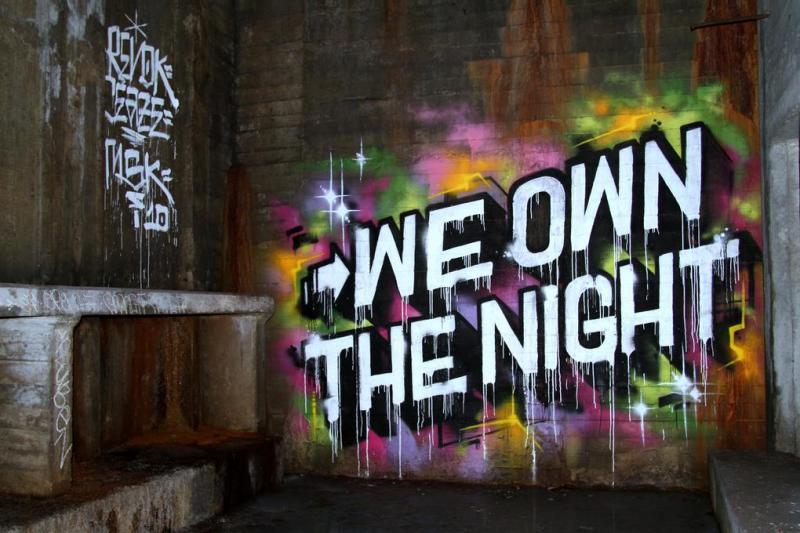
New York, late August 2010
I am at the opening of a swanky new gallery. Around me, the latest daubs by the hottest names adorn the walls of room after room. It’s worth mentioning a couple of discrepancies from your regular opening. This is a canapé-free environment, for one. There is no chilled white wine, no pretentious appraisal of carefully lit works. Nobody has come dressed to thrill. In fact, nobody has come at all. Apart from me.
As it happens, I am the only person who will ever be invited to view the complete collection, and it’s not as if I’m even a guest. I am here as an independent witness to testify that this place does exist, that it is not an elaborate art hoax mocked up in a studio. After tonight, the gallery will be sealed off for ever, and all the art entombed within it. This is the opening night, but it is also the closing night.
It is for this reason that I can’t say where I am. The location is entirely top secret. OK, I can say I’m in New York City. To be more specific, I am under New York. But that is it. I can give away no more specifics. Why? Because what I am about to describe is totally and utterly illegal. Welcome to The Underbelly Project, an artistic venture of towering ambition, matchless audacity and sheer bloody cheek.
*
We muster at street level. Me, a couple of gents in arty fatigues, and a camerawoman. Naturally I can’t say where the rendezvous point is. It is still light and warm when we turn and head down into the subway. I’ve been told it’ll be hot down there, so have come to work in a breathable running top. We zap through the barrier and onto the platform. The idea, I’ve been advised, is to look inconspicuous. Not hard, in a city peopled by individualists featuring every conceivable mixture of ethnicity and gender. But still, we are careful not to acknowledge one another’s presence as a train pulls in. We get on and coolly pretend we’ve never met. Which in my case was, until 10 minutes earlier, entirely true.
In terms of dodging arrest this has been in a different league
At the next stop we alight. In the interests of security, I am not at liberty to describe the station. There are subway buffs out there who can definitely identify the line from the colour of the tiles, and probably name the station from the quality of the grouting. They’re called “foamers” because they froth rabidly at the mouth at all forms of subway stuff. “This project,” advises Workhorse, “will probably be like crack to the foamers.” Workhorse – not his real name – is one of my guides into the underworld. I could describe his appearance but as he looks highly particular it would make the NYPD’s job of rounding him up and clapping him in irons a little too easy. It suffices to say that in the vagabond art form known as street art, whose practitioners are used to dodging the law and shrouding their ID behind a nom de guerre, he is a significant figure.
He and PAC, a slightly younger and leaner street artist, have been toiling away at the Underbelly Project for 18 months. Between them they’ve made perhaps 75 visits to the site. This is to be the last. After tonight, their only connection to the place will be in the form of photographs and film. Both are jittery with tension. PAC has had a last smoke before descending, also a stiffening shot of vodka. They’ve made it this far. If they get through tonight, they will have successfully brought more than 100 artists to the site, undetected and unprosecuted. For a couple of slacker-dude outsider types, not obvious inheritors of the military-precision gene, it’s been one hell of an undertaking. There have been a few scrapes, mind. Street artists – practitioners of what’s also known as urban art – are used to working more or less alone under cover of darkness, but in terms of dodging arrest this has been in a different league. Back above ground they have kept stum about it ever since. Not a word has squeaked out into a media environment where news goes viral in a nano-section. Until now.
Neither Workhorse nor PAC is quite sure where they stand in the eyes of the law. They could easily face a bog-standard trespassing charge, but street artists are used to clambering over wire fencing and stealing onto private property. “The thing that we're uncertain about,” says Workhorse, “is with this being the subway, and the magnitude of the project, if they wanted to say we're messing up the infrastructure and bring Homeland Security in and talk terrorism.” It’s true that New York is in the grip of terrorism paranoia. Midway through the project a US national called Faisal Shahzad tried and failed to detonate a car in Times Square. Security alerts went off the chart and that week it was simply too risky to bring down Shepard Fairey, the internationally renowned street artist who designed Barack Obama’s 2008 Hope campaign posters. “The concern,” adds PAC, “is that a tabloid paper paints it as we could’ve built a nuclear bomb down here with that many visits, and then we’ll have to be made an example of.”
It being a Sunday and the station stop not slap dab in the epicentre of Manhattan, the platform gradually empties. Workhorse turns and leads us to the far end of the platform. I’m told to go second, 10 yards behind. I round a corner and officially enter a world which most New Yorkers never see, or even know about.
My pulse starts to race. This kind of excitement is not normally available to arts journalists (the PRs see to that). The surface underfoot suddenly turns rough and damp. My hand-torch – we’ve got two between four – picks out puddles among the loose cement. We clamber over various obstacles – details of what and how withheld – until we are in an empty space. In the dark, lit by our torches, it’s more like a concrete cave. I get the impression that pretty much nobody has been down here in decades.
“So where's the restroom?” I ask.
“You’re standing in it,” says Workhorse.
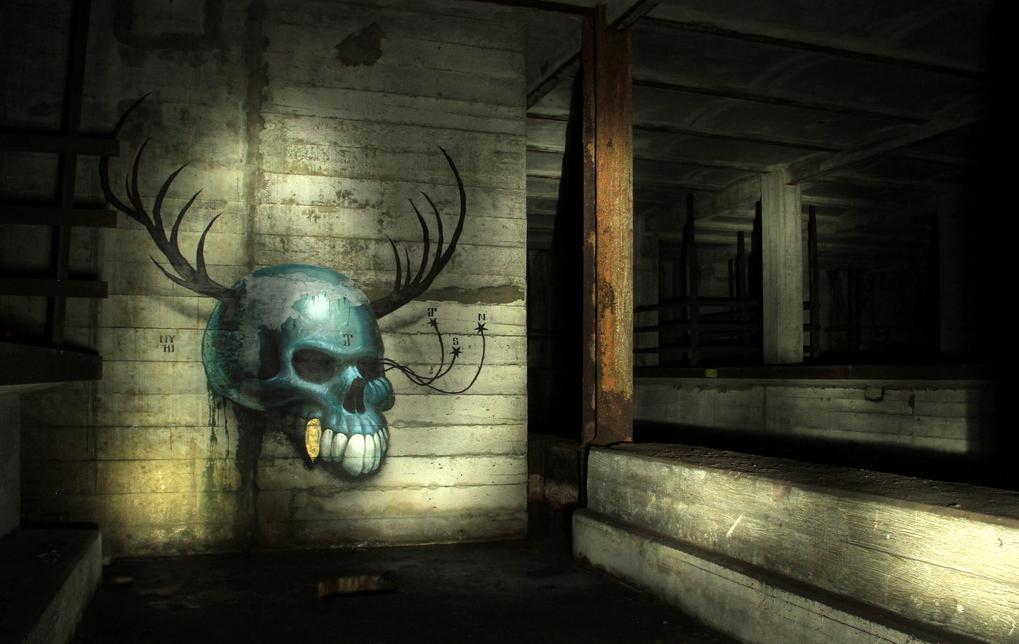 PAC, who is carrying a powerful square-shaped multi-bulb flood lamp, fires it up, hoists it onto his hip and directs it out front. And there, suddenly irradiated in the beam, is the ghost of a subway station. All square pillars and lowering ceiling, it looks like something created by a latter-day Brunelleschi. The light collides with colonnades of grey struts stretching all the way back to a far wall. I take in the spectral contours of the space: empty beds where railway tracks were never laid, access points where staircases were never built, hollow drops where escalators were never fitted. And platforms where passengers never waited for trains.
PAC, who is carrying a powerful square-shaped multi-bulb flood lamp, fires it up, hoists it onto his hip and directs it out front. And there, suddenly irradiated in the beam, is the ghost of a subway station. All square pillars and lowering ceiling, it looks like something created by a latter-day Brunelleschi. The light collides with colonnades of grey struts stretching all the way back to a far wall. I take in the spectral contours of the space: empty beds where railway tracks were never laid, access points where staircases were never built, hollow drops where escalators were never fitted. And platforms where passengers never waited for trains.
In the distance the beam catches a lurid flash of colour. It swerves onto another. Floor-to-ceiling images adorn distant walls, much like posters on subway platforms. Here, apparently, is artwork after outsize artwork. It feels as if I’ve stumbled into the 21st-century equivalent of the caves at Lascaux. Instead of drawings of Palaeolithic quadrupeds, scrawled onto walls 17,000 years ago, there are lurid images that carbon-date the work to right here, right now. At a glance, I can see gawping heads, writhing figures, letter clusters in graffiti’s signature font, riotous splashes and swooshes of attention-seeking colour.
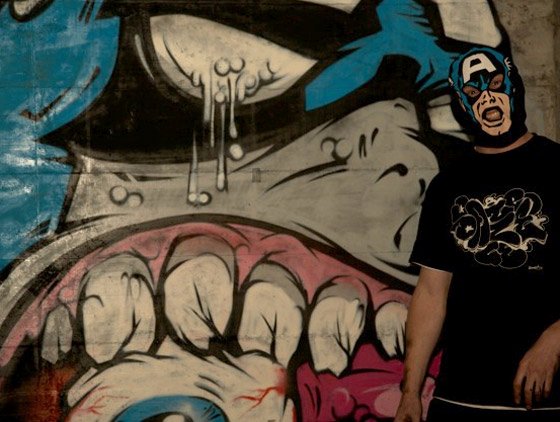 I can see only a tiny fraction of what’s here, covering every available wall space. This contemporary time capsule features 100 works of street art by artists from all over the world. There is no Guggenheim Museum for a fugitive art form whose works are sprayed and pasted on public walls in the dead of night. Instead, all of a sudden, there’s this: a renegade installation planted furtively under the busiest city in the world. I have never seen anything like it. Nor has anyone else. And here’s the thing: nor will they. But why on earth would anyone create something on such a scale that nobody else will ever get to see?
I can see only a tiny fraction of what’s here, covering every available wall space. This contemporary time capsule features 100 works of street art by artists from all over the world. There is no Guggenheim Museum for a fugitive art form whose works are sprayed and pasted on public walls in the dead of night. Instead, all of a sudden, there’s this: a renegade installation planted furtively under the busiest city in the world. I have never seen anything like it. Nor has anyone else. And here’s the thing: nor will they. But why on earth would anyone create something on such a scale that nobody else will ever get to see?
It’s Workhorse who pipes up with an oral version of their manifesto. “In the beginning,” he says, “street art was something you did because you didn't fit in anywhere else. The 'don't give a fuck' attitude was about doing it yourself. Fuck the galleries. If they don't like your work then put it on the fucking street and ram it down their fucking throats. But for the last few years urban art was getting ridiculous. You could go out with some cute little character that you drew, or some quirky saying, and put it up everywhere for a few months, then do a gallery show and cash in on the sudden interest in urban art. It really was that easy for a while. Banksy pieces that were selling for $600 one year were suddenly selling for $100,000 a few years later. It was nuts. People were going out and literally sawing walls in half to steal Banksy pieces. Electrical panels were being ripped off leaving live wires exposed that had Shepard Fairey stencils on them. It was commercialism at its worst. This atmosphere starts to fuck things up. Early in the street-art years, I relished the ability to feel like I was my own island. The Underbelly was our way of feeling like we were an island again. We finally had a space in the world that collectors couldn't contaminate. A space that couldn't be bought.”
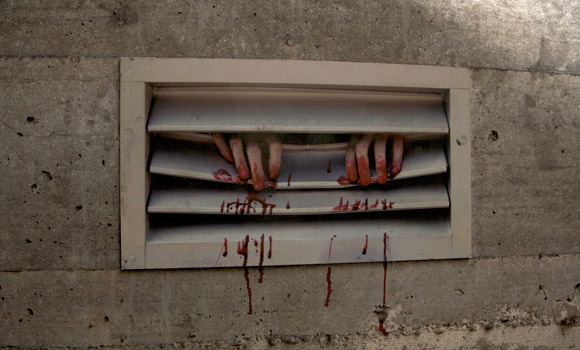 Art, in other words, for art’s sake. The Underbelly credo is hardly original: artists throughout history have similarly striven to purge themselves of the marketplace. But in 2010 a purist has to go the extra mile to escape from Mammon’s siren wail. Hence 100 of them flocking to this underground hideout where cellphones won’t trill and money can’t talk. Workhouse seems a benign type, but there’s no missing the punkish inner rage that fuels him. PAC, an even more hardline advocate of creative cleanliness, was all for not publicising the existence of Underbelly at all. “But we can’t just put in a year and a half and deny the fact that we did something like this,” he says. They also figure that it’ll work as a recruiting tool for future projects: they’re already got sites lined up under Paris and Las Vegas.
Art, in other words, for art’s sake. The Underbelly credo is hardly original: artists throughout history have similarly striven to purge themselves of the marketplace. But in 2010 a purist has to go the extra mile to escape from Mammon’s siren wail. Hence 100 of them flocking to this underground hideout where cellphones won’t trill and money can’t talk. Workhouse seems a benign type, but there’s no missing the punkish inner rage that fuels him. PAC, an even more hardline advocate of creative cleanliness, was all for not publicising the existence of Underbelly at all. “But we can’t just put in a year and a half and deny the fact that we did something like this,” he says. They also figure that it’ll work as a recruiting tool for future projects: they’re already got sites lined up under Paris and Las Vegas.
We are speaking sotto voce, almost whispering. Sound reverberates in this hollow chasm, and can escape through cavities to places where it might be heard. The regular clatter of trains thundering past sometimes muffles our voices altogether. Light streaks across the walls of the site like film being fed slowly through a projector, scattering transitory illumination across eerie works that will never be seen in the light.
*
Did its citizens but know it, the New York subway is home to a considerable labyrinth of abandoned spaces which were once destined to become stations and, for whatever reason, never made it. When three independent subway companies from the early 1900s merged, for example, construction was rationalised. The 1920s crash in certain cases halted it altogether. Later, longer trains rendered some stations unusable. Extended platforms put some impracticably close together. One station under New York City Hall with brick-vaulted ceilings and skylights is even open for tours from the Transit Museum. But most are known only to a renegade band of urban explorers, as they are known: people who stop at nothing to seek out the city’s desolate nooks and crannies.
It was one of these who introduced PAC to the station in 2005. For a couple of years he would sporadically visit. “I would hang out here for hours at a time as somewhere to get inspiration,” he says, “enjoy the architecture, enjoy the solitude of being underground.” Then he met Workhorse, a theme of whose work is reclaiming abandoned spaces, while helping him to hang a show. “I told him I knew about a space that was pretty cool, brought him down here, and that night the idea for the project hatched.”
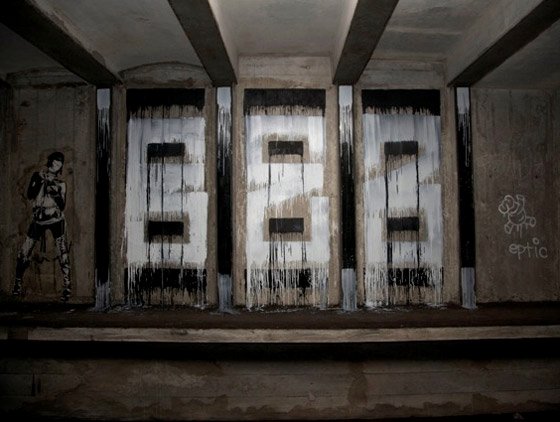 The Underbelly Project took on epic proportions as soon as they realised that they couldn’t possibly hope to cover the walls by themselves and a few friends. So they decided to put the word out in urban art’s clandestine community: they’d stop after a year, or when they reached 100 works, whichever came first. We walk along a series of platforms and ledges towards a small room off the far end where the first images were painted. PAC shines the light on a striking jolie-laide image of a two-tone face, orange and white, with seductively hooded eyes and buck teeth. Utterly arresting, it’s by a well-known artist who can’t be named. (Pictured below: Jasper Rees in front of image.)
The Underbelly Project took on epic proportions as soon as they realised that they couldn’t possibly hope to cover the walls by themselves and a few friends. So they decided to put the word out in urban art’s clandestine community: they’d stop after a year, or when they reached 100 works, whichever came first. We walk along a series of platforms and ledges towards a small room off the far end where the first images were painted. PAC shines the light on a striking jolie-laide image of a two-tone face, orange and white, with seductively hooded eyes and buck teeth. Utterly arresting, it’s by a well-known artist who can’t be named. (Pictured below: Jasper Rees in front of image.)
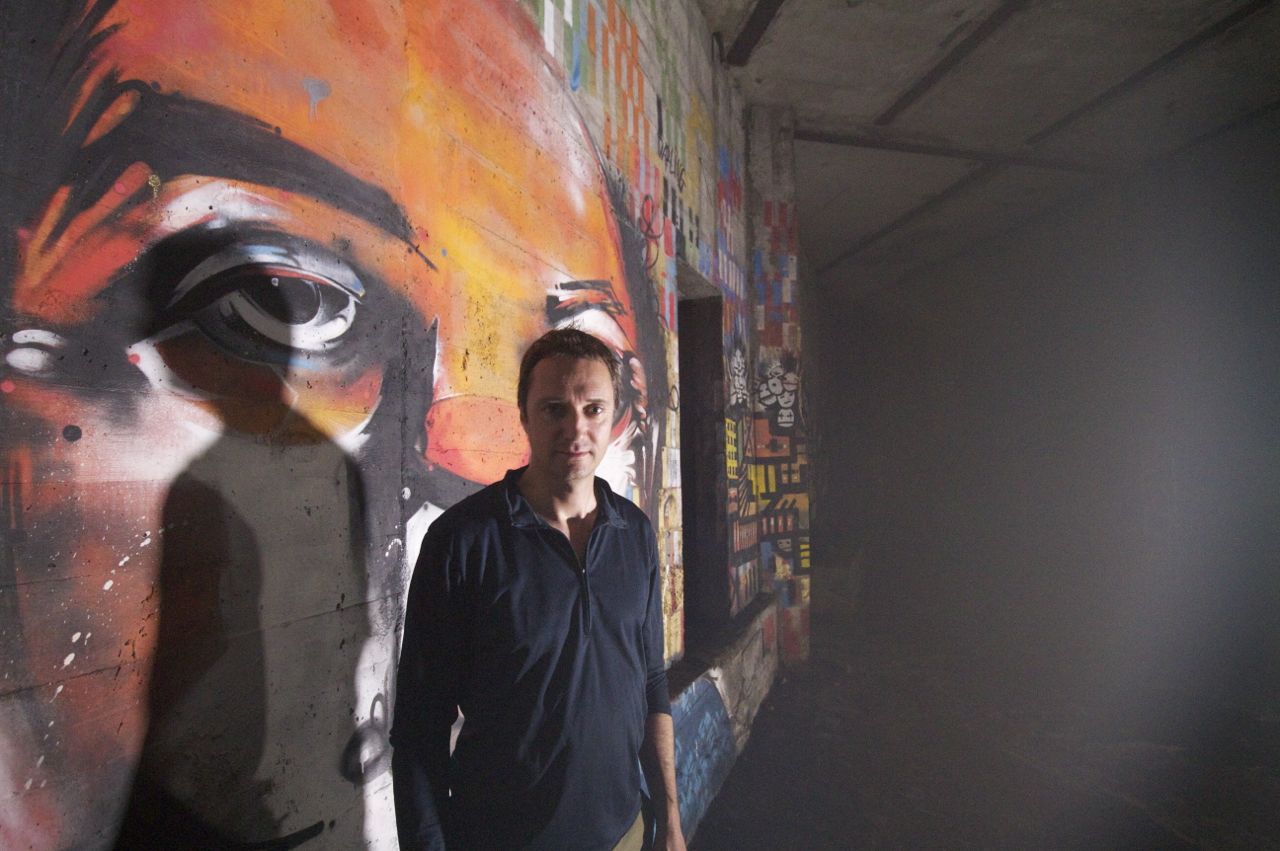 At that point they didn’t quite know how much labour they’d let themselves in for. “We came in here early,” recalls Workhorse, “and stayed until about 6 [in the morning]. We were all so energised, we went back to my house and had margaritas at 7. We went to bed and learned when I woke up how filthy the place is. We had tromped mud all over the place.” The other thing they realised was that, for such a huge undertaking, certain rules had to be enforced. Every artist would need escorting, and while more than one could come down on the same night, their guides would need to make a minimum of 60 visits each. So they imposed a time limit. Four hours to work. No exiting for more materials. No coming back. They also had to pay their own expenses – including air travel – and generally subsume their ego to the wider mission. Naturally there was no talk of remuneration.
At that point they didn’t quite know how much labour they’d let themselves in for. “We came in here early,” recalls Workhorse, “and stayed until about 6 [in the morning]. We were all so energised, we went back to my house and had margaritas at 7. We went to bed and learned when I woke up how filthy the place is. We had tromped mud all over the place.” The other thing they realised was that, for such a huge undertaking, certain rules had to be enforced. Every artist would need escorting, and while more than one could come down on the same night, their guides would need to make a minimum of 60 visits each. So they imposed a time limit. Four hours to work. No exiting for more materials. No coming back. They also had to pay their own expenses – including air travel – and generally subsume their ego to the wider mission. Naturally there was no talk of remuneration.
“We said, ‘You have to do this out of interest and love for what we're doing. This is not about you basically,’” says Workhorse. “We didn’t want to bring down people if their heads were too big and they wanted to be the main player. We didn't tell them who else was involved. It would be easy to get someone in if we told them, ‘We have Swoon, Faile, Ron English, Revok and The London Police.’ We wanted people involved because they liked the project, because they liked to paint, and because they were tired of the way urban art was being commodified.”
 Those are just some of the stellar urban artists who give the Underbelly Project its artistic credibility. Ron English, the daddy among Underbelly’s artists, can shift his work above ground for tens of thousands of dollars. Faile, a Brooklyn collective, have exported their sly comic-book style to public wall spaces across the world. The London Police’s bubbly kinder-art has been shown in galleries all over Europe. Revok’s swirly graphics covered acreages of public wall from California to Japan. Swoon, a Brooklyn urban-art activist, made waves at the 2009 Venice Biennale when, uninvited, she sailed a floating cityspace sculpture made out of trash down the Grand Canal at 3am.
Those are just some of the stellar urban artists who give the Underbelly Project its artistic credibility. Ron English, the daddy among Underbelly’s artists, can shift his work above ground for tens of thousands of dollars. Faile, a Brooklyn collective, have exported their sly comic-book style to public wall spaces across the world. The London Police’s bubbly kinder-art has been shown in galleries all over Europe. Revok’s swirly graphics covered acreages of public wall from California to Japan. Swoon, a Brooklyn urban-art activist, made waves at the 2009 Venice Biennale when, uninvited, she sailed a floating cityspace sculpture made out of trash down the Grand Canal at 3am.
For the record, Banksy was asked, but it was while he was promoting his film Exit Through the Gift Shop. “We didn't have direct communication with him,” says Workhorse, “but we did talk through a mutual friend. He said, ‘Great project, love it, but I can't risk going in in the middle of the tour for this movie.’” So there you have it: the Underbelly Project was too scary even for street art’s most daring adventurer.
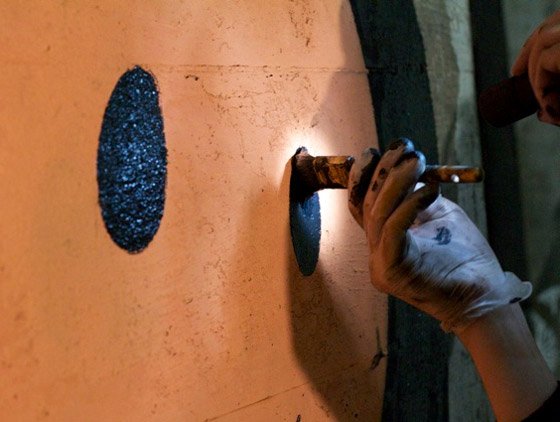 The artists who came down were more or less self-selecting. “We tried to make sure we had a true cross section of what’s going on, not just current favourites: old-school guys, new-school guys, up-and-coming guys, and plenty of girls.” (Ten female artists came down by their reckoning.) Most names speak of withheld identities and covert operations: Specter, Demer, Boxi (pictured above left), Aiko, SheOne, Poster Child, Roa, Saber, Trusto Corp, Sinboy, Big Foot, Flying Fortress, Remi/Rough, Elbow Toe, Imminent Disaster. They came from all over: Japan, Israel, Canada, Australia, France, Mexico, Spain. PAC was approached by a Romanian artist seeking an opening in New York. “I looked at his work and said, ‘Why don't you come do a piece for this project I've got going on?’” Several British artists are represented, not only the Amsterdam-based The London Police (pictured above right), but also Lucy Maclaughlan, Apish Angel, O Two (pictured below right), Remi/Rough and SheOne.
The artists who came down were more or less self-selecting. “We tried to make sure we had a true cross section of what’s going on, not just current favourites: old-school guys, new-school guys, up-and-coming guys, and plenty of girls.” (Ten female artists came down by their reckoning.) Most names speak of withheld identities and covert operations: Specter, Demer, Boxi (pictured above left), Aiko, SheOne, Poster Child, Roa, Saber, Trusto Corp, Sinboy, Big Foot, Flying Fortress, Remi/Rough, Elbow Toe, Imminent Disaster. They came from all over: Japan, Israel, Canada, Australia, France, Mexico, Spain. PAC was approached by a Romanian artist seeking an opening in New York. “I looked at his work and said, ‘Why don't you come do a piece for this project I've got going on?’” Several British artists are represented, not only the Amsterdam-based The London Police (pictured above right), but also Lucy Maclaughlan, Apish Angel, O Two (pictured below right), Remi/Rough and SheOne.
SheOne, a Londoner with 20 years on the clock as a graffiti artist, was one of the last in. “There were some nerves. And a certain amount of adrenalin kicked in. It was pitch black so I didn’t really get to see much of the other artists work but it is a unique environment to create a mural in. People are going to be really, really surprised that it’s a brilliant cross section in one place. You’ve got all these artists like Ron English and Obey working in high-end galleries and yet they’re still open to doing this kind of work. It’s never been done before. To have them all in one place is quite a coup.”
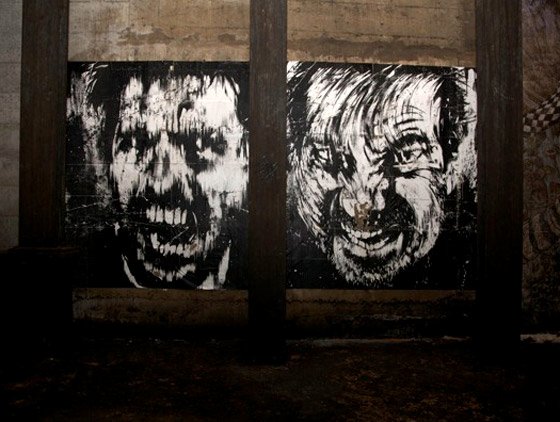 Remi/Rough got the call via Australian street artist Stormie Mills after Workhorse heard about a project of his painting a 1970s Scottish coastal tenement that had never been occupied. “For two weeks I was agreeing to go to New York and do something without having any idea what it was.” He was staggered by the organisation, which involved inspecting an online map of the site and precise instructions about how long he and Stormie Mills would be held on the platform before being taken in. “Getting 20 artists together in a space can be an absolute nightmare but to get 100 over a long period of time and allocate space is profound. I’ve travelled all round the world but this was by far the strangest place I’ve ever painted. I felt completely out of my comfort zone. It had a really strong effect on me.”
Remi/Rough got the call via Australian street artist Stormie Mills after Workhorse heard about a project of his painting a 1970s Scottish coastal tenement that had never been occupied. “For two weeks I was agreeing to go to New York and do something without having any idea what it was.” He was staggered by the organisation, which involved inspecting an online map of the site and precise instructions about how long he and Stormie Mills would be held on the platform before being taken in. “Getting 20 artists together in a space can be an absolute nightmare but to get 100 over a long period of time and allocate space is profound. I’ve travelled all round the world but this was by far the strangest place I’ve ever painted. I felt completely out of my comfort zone. It had a really strong effect on me.”
But the majority were their fellow Americans - appropriately given the origins of the modern urban art movement in 1970s New York, when graffiti artists started covering subway trains with their tags – graffiti argot for a signature. In the 1980s the work of street artists like Jean-Michel Basquiat and Keith Haring (both dead by 1990) took the movement off the walls of Manhattan and into galleries, museums, international biennials and, above all, auction houses.
The Underbelly Project is rooted in that early history. Among graffiti’s breakthrough generation was the fraternal duo Smith and Sane, who used to put up their tags all over the city. Their most ambitiously placed tag on Brooklyn Bridge made it onto the cover of The New York Times and sparked a public outcry about defacing public buildings. The city pressed charges. Sane subsequently fell to his death from the same bridge, though whether it was a suicide or an accident was never established. Smith’s contribution to the Underbelly Project is a huge piece that reads SANE. “The funniest part,” says PAC, “is that Smith nowadays works for the transportation system."
For two and a half hours I take the tour, Workhorse and PAC walking me past each piece. They fall eclectically into the three main schools of “what’s happening upstairs”, as they put it: graffiti-style tagging, street art and urban installation. The work ranges from simple statement to dense allusion, from vast and bold, lurid and DayGlo to subtle and pernickety, intricate and arcane.
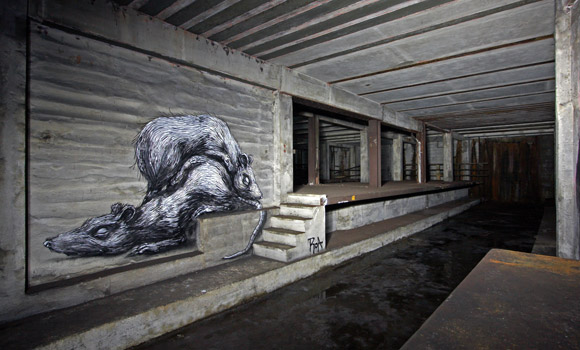 Some works are shiny with childlike rainbow-coloured optimism. One artist has counterintuitively daubed a huge red-and-white flower up the wall, as if anything could grow down here. Another is “just trying to put happiness in dark places”, says Workhorse: the work in question is a basic piece of circuitry in a box which beams a hologram of Eadweard Muybridge’s workmen hammering in tandem. But the pieces which grab me are the ones are more sinisterly in sync with the space - skullheads and creepy profiles, Hadean spectres and a pair of huge scuttling rats. One set of typographical strokes, which turns out to be SheOne’s, look remarkably like the skeletal scratches of a Lascaux-like cave painter.
Some works are shiny with childlike rainbow-coloured optimism. One artist has counterintuitively daubed a huge red-and-white flower up the wall, as if anything could grow down here. Another is “just trying to put happiness in dark places”, says Workhorse: the work in question is a basic piece of circuitry in a box which beams a hologram of Eadweard Muybridge’s workmen hammering in tandem. But the pieces which grab me are the ones are more sinisterly in sync with the space - skullheads and creepy profiles, Hadean spectres and a pair of huge scuttling rats. One set of typographical strokes, which turns out to be SheOne’s, look remarkably like the skeletal scratches of a Lascaux-like cave painter.
There is an expected amount of anarchic sloganeering and sly digs at the corporate-commercial complex. “WE OWN THE NIGHT” blares one painting on an end wall in italicised upper case. Another is plastered in a woozy, zig-zagged Stars and Stripes banner. One artist in the throes of a break-up deposited his dreams of moving home on the wall in the cartoon form of a walking house.
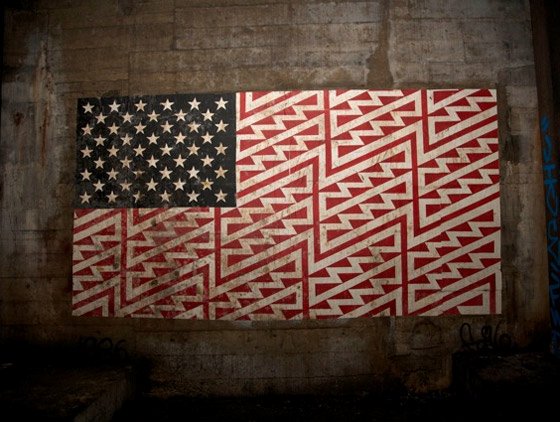 Workhorse reserved a cinemascopic space for himself and used his time slot to create a minutely detailed stencil-based image of himself in an empty subway carriage. “I just liked the idea of this ghost train passing through the station for all of eternity, me sitting here.” The piece took more than two weeks to prepare, he adds, only three hours to spray. The working conditions were not ideal. “The tape doesn't stick to the walls so I had to keep hitting the tape to literally bash it into the divots in the wall. I woke up the next morning and couldn't write because I had hit it so much with the palm of my hand.” PAC’s piece, done in a small box-like space, plays cleverly on the damp atmosphere: an intoxicating trompe l’oeil of black and white rhomboids whose careful patterning has been disfigured by sliding drips of paint.
Workhorse reserved a cinemascopic space for himself and used his time slot to create a minutely detailed stencil-based image of himself in an empty subway carriage. “I just liked the idea of this ghost train passing through the station for all of eternity, me sitting here.” The piece took more than two weeks to prepare, he adds, only three hours to spray. The working conditions were not ideal. “The tape doesn't stick to the walls so I had to keep hitting the tape to literally bash it into the divots in the wall. I woke up the next morning and couldn't write because I had hit it so much with the palm of my hand.” PAC’s piece, done in a small box-like space, plays cleverly on the damp atmosphere: an intoxicating trompe l’oeil of black and white rhomboids whose careful patterning has been disfigured by sliding drips of paint.
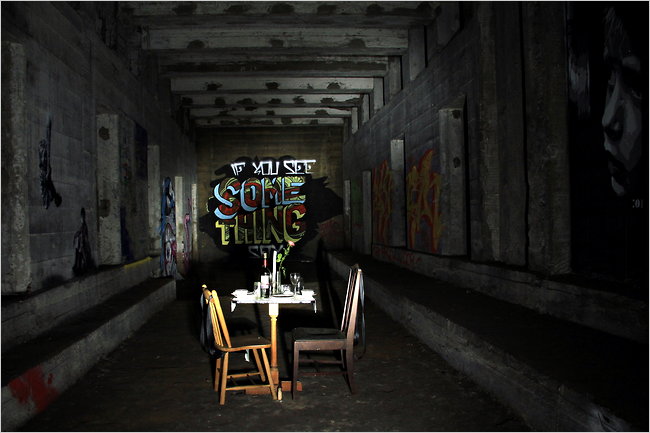 The site mostly comprises a series of parallel railway beds, all closed off at both ends. As we walk from one to another, along platforms and railway beds, there suddenly looms out of the darkness perhaps the most curious contribution to the Underbelly Project. It’s a table laid for dinner, with two chairs, two place settings, a candle, a bottle (pictured right). And this is where I discover that I’m not quite the only outsider to have been down here. The piece is by an artist called Jeff Stark, known for carefully choreographing dinners for 40 in abandoned spaces around the city. “We couldn't bring down 40 people,” says PAC, “so I told him he could bring down two for a dinner date. He put out a call and they had to write an essay saying why they should be the people chosen. He didn't tell them anything, just said, ‘You're gonna go some place illegal and we’ll serve you dinner.’” The winners were two young women who came along in 1920s attire, with pearls and heels. They had a tour while the artist set up, then sat down to a five-course meal. Like something off the Marie Celeste, the table is the only evidence that anyone ever dined in this most exclusive New York eaterie.
The site mostly comprises a series of parallel railway beds, all closed off at both ends. As we walk from one to another, along platforms and railway beds, there suddenly looms out of the darkness perhaps the most curious contribution to the Underbelly Project. It’s a table laid for dinner, with two chairs, two place settings, a candle, a bottle (pictured right). And this is where I discover that I’m not quite the only outsider to have been down here. The piece is by an artist called Jeff Stark, known for carefully choreographing dinners for 40 in abandoned spaces around the city. “We couldn't bring down 40 people,” says PAC, “so I told him he could bring down two for a dinner date. He put out a call and they had to write an essay saying why they should be the people chosen. He didn't tell them anything, just said, ‘You're gonna go some place illegal and we’ll serve you dinner.’” The winners were two young women who came along in 1920s attire, with pearls and heels. They had a tour while the artist set up, then sat down to a five-course meal. Like something off the Marie Celeste, the table is the only evidence that anyone ever dined in this most exclusive New York eaterie.
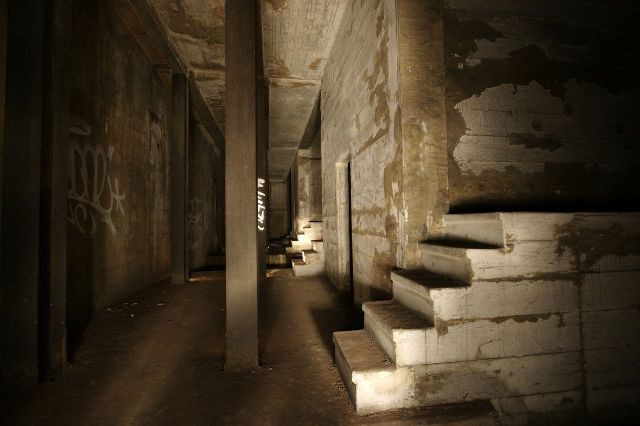 But mostly the artists came down in ones and twos and occasionally fours, donned their face masks and head torches and set to work. It didn’t always go smoothly. At the end of one short night’s work, the Brooklyn collective Faile and the celebrated anti-corporate raider Ron English had both finished in good time. “Just as we were packing up to leave,” says PAC, “I heard some noises, looked down on the platform, and workers were setting up to do serious track work so we sat in the pitch black for four hours while these guys sawed steel and Ron English paced back and forth yelling and screaming about picking his kid up from soccer practice. They were both saying, ‘We're gonna go down,’ and I was saying, ‘No, you can't. I have to come to this station another 40 times.’ It turned into the longest night.”
But mostly the artists came down in ones and twos and occasionally fours, donned their face masks and head torches and set to work. It didn’t always go smoothly. At the end of one short night’s work, the Brooklyn collective Faile and the celebrated anti-corporate raider Ron English had both finished in good time. “Just as we were packing up to leave,” says PAC, “I heard some noises, looked down on the platform, and workers were setting up to do serious track work so we sat in the pitch black for four hours while these guys sawed steel and Ron English paced back and forth yelling and screaming about picking his kid up from soccer practice. They were both saying, ‘We're gonna go down,’ and I was saying, ‘No, you can't. I have to come to this station another 40 times.’ It turned into the longest night.”
Another time Workhorse was about to leave with a young Australian artist when he saw workers walking down on the track and they had to beat a hasty retreat back to the site. “As we're running back, the girl I was with has two left feet, falls off the platform in the pitch black and I think she broke her back. She’s twisted on the floor moaning. I wanna make sure she doesn't make a noise but if she's injured I have to take her out. Turns out she's OK.” They sat and waited in the dark for three and a half hours.
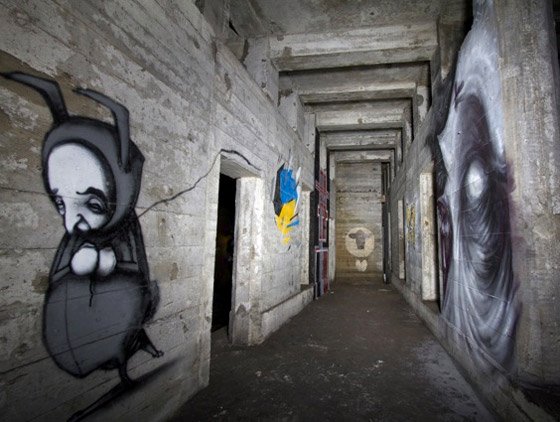 It’s not a pleasant place to hang out in the pitch black. We are nearing the end of my guided tour. I’ve just been looking at another outlandish sprawl when Workhorse pipes up: “So try to imagine if you come here and you have no idea where your orientation is, and you come up on this place and find that.” And he suddenly flicks a torch beam onto a small hooded figure in jeans crouching against the wall. I jump clean out of my skin. Turns out it’s a body sculpture made out of tape. I lean in close and note that the maquette face already has mould growing on it.
It’s not a pleasant place to hang out in the pitch black. We are nearing the end of my guided tour. I’ve just been looking at another outlandish sprawl when Workhorse pipes up: “So try to imagine if you come here and you have no idea where your orientation is, and you come up on this place and find that.” And he suddenly flicks a torch beam onto a small hooded figure in jeans crouching against the wall. I jump clean out of my skin. Turns out it’s a body sculpture made out of tape. I lean in close and note that the maquette face already has mould growing on it.
Which begs the question: how long can this time capsule or urban art last? Plainly there’s the fear that it will be disinterred and destroyed by law enforcement officials sent down to investigate by the Metropolitan Transportation Authority. But time and humidity is already working away at the poster images fixed to the wall with organic wheat paste. One thickly sprayed painting has simply never dried. They reckon the painted works will last two or three decades. “I like the fact that by the time somebody figures out where this is and gets in,” says PAC, “it'll be apocalyptic because things will be deteriorating and it'll be this memory.”
*
Our time is done. We are back where we started, at the exit point. PAC parks his flood lamp at an angle on the floor for the final time and produces a tall bottle of warm beer, cracks it open and pours it into four plastic cups. The mission, stretching back over 18 months and involving 75 sorties, has been accomplished. A creative venture of unimaginable scale requiring a massive commitment of time, energy, focus and, above all, secrecy has finally been completed. We’ve still got to get out without being spotted, and this time they’re removing access to the site. So if anything goes wrong there’ll be no escape route. We’ll be done up like kippers. Workhorse is visibly still tense, and not quite ready for celebration. PAC is more reflective when I ask him how he feels to be leaving: “It's time to seal it up,” he says, drawing on a valedictory cigarette. “Every time I walk over a subway grate and smell that air coming up I'll remember this station.”
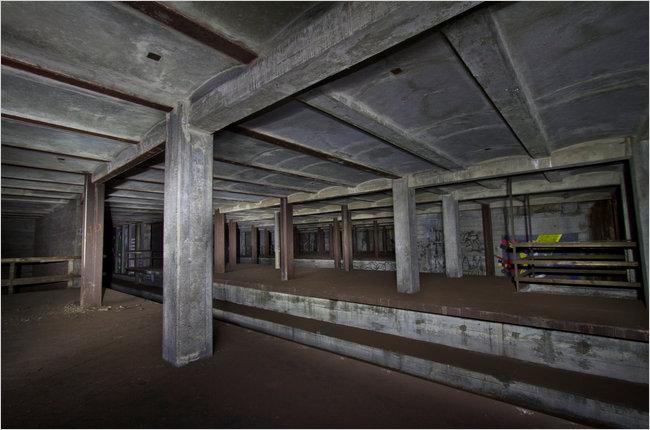 They toast their epic efforts in a kind of demob-happy frenzy. They’re like schoolboys at the end of the summer term, wired with giggly exhilaration. Stories jumble out. You can see their time down here flash across their faces. It’s time to leave. As they gather their stuff and make for the exit, PAC looks up and notices something. It’s a light fitting dangling from the ceiling. After the hundreds of dollars spent on batteries, they’ve found a source of electricity. The abandoned subway station, this vast vacant husk whose walls they have conspiratorially adorned, has played one last hilarious trick back on them at the death.
They toast their epic efforts in a kind of demob-happy frenzy. They’re like schoolboys at the end of the summer term, wired with giggly exhilaration. Stories jumble out. You can see their time down here flash across their faces. It’s time to leave. As they gather their stuff and make for the exit, PAC looks up and notices something. It’s a light fitting dangling from the ceiling. After the hundreds of dollars spent on batteries, they’ve found a source of electricity. The abandoned subway station, this vast vacant husk whose walls they have conspiratorially adorned, has played one last hilarious trick back on them at the death.
We clamber out much as we clambered in. This time they hurriedly destroy the means of egress. And then we exit as we entered, in single file, 10 yards apart. The platform is deserted. After a few minutes a train pulls in and we step on, travel one stop, get off, push through the barrier and saunter up a flight of stairs into the teeming broiling honking New York night. Nobody knows. Literally. Nobody up here knows...
November 2010
No sooner had the story come out than the thing went viral. Images posted on the Underbelly site were ripped off and stuck up on a string of street-art blogs. The subway station, whose identity had been so carefully protected, was instantly revealed by a New York City blogger with an encyclopaedic knowledge of the subway - a foamer. People started making their way to the subway and trying to penetrate the site. Eventually the MIT stuck up exclusion tape. Some were arrested. Among those who managed to get through early on were two who took it upon themselves to vandalise much of the art by spraying it with yellow tags then posting the images online.
The project could not have had greater integrity if it had been nailed to a cross
It’s hard to speculate what their motivation can have been beyond puerile self-regard. You could also read their intervention as simply another chapter in the biography of the project. Workhorse always argued that, much like any street art only a lot more so, the Underbelly’s afterlife as a gallery would be online. Anything that happened to the actual paintings was sort of immaterial.
There was also dissent. If the artists were so eager to cleanse themselves of the stench of commerce and create art for its own sake, why publicise the story at all? This seemed to smack of envy in a world where some artists are uniquely eager to demonstrate the extent of their integrity. To me the project could not have had greater integrity if it had been nailed to a cross. A protest that reaches the ears of no one is not much of a protest.
Share this article
The future of Arts Journalism
You can stop theartsdesk.com closing!
We urgently need financing to survive. Our fundraising drive has thus far raised £49,000 but we need to reach £100,000 or we will be forced to close. Please contribute here: https://gofund.me/c3f6033d
And if you can forward this information to anyone who might assist, we’d be grateful.

Subscribe to theartsdesk.com
Thank you for continuing to read our work on theartsdesk.com. For unlimited access to every article in its entirety, including our archive of more than 15,000 pieces, we're asking for £5 per month or £40 per year. We feel it's a very good deal, and hope you do too.
To take a subscription now simply click here.
And if you're looking for that extra gift for a friend or family member, why not treat them to a theartsdesk.com gift subscription?
more Visual arts
 'We are bowled over!' Thank you for your messages of love and support
Much-appreciated words of commendation from readers and the cultural community
'We are bowled over!' Thank you for your messages of love and support
Much-appreciated words of commendation from readers and the cultural community
 Folkestone Triennial 2025 - landscape, seascape, art lovers' escape
Locally rooted festival brings home many but not all global concerns
Folkestone Triennial 2025 - landscape, seascape, art lovers' escape
Locally rooted festival brings home many but not all global concerns
 Sir Brian Clarke (1953-2025) - a personal tribute
Remembering an artist with a gift for the transcendent
Sir Brian Clarke (1953-2025) - a personal tribute
Remembering an artist with a gift for the transcendent
 Emily Kam Kngwarray, Tate Modern review - glimpses of another world
Pictures that are an affirmation of belonging
Emily Kam Kngwarray, Tate Modern review - glimpses of another world
Pictures that are an affirmation of belonging
 Kiefer / Van Gogh, Royal Academy review - a pairing of opposites
Small scale intensity meets large scale melodrama
Kiefer / Van Gogh, Royal Academy review - a pairing of opposites
Small scale intensity meets large scale melodrama
 Jenny Saville: The Anatomy of Painting, National Portrait Gallery review - a protégé losing her way
A brilliant painter in search of a worthwhile subject
Jenny Saville: The Anatomy of Painting, National Portrait Gallery review - a protégé losing her way
A brilliant painter in search of a worthwhile subject
 Abstract Erotic, Courtauld Gallery review - sculpture that is sensuous, funny and subversive
Testing the boundaries of good taste, and winning
Abstract Erotic, Courtauld Gallery review - sculpture that is sensuous, funny and subversive
Testing the boundaries of good taste, and winning
 Edward Burra, Tate Britain review - watercolour made mainstream
Social satire with a nasty bite
Edward Burra, Tate Britain review - watercolour made mainstream
Social satire with a nasty bite
 Ithell Colquhoun, Tate Britain review - revelations of a weird and wonderful world
Emanations from the unconscious
Ithell Colquhoun, Tate Britain review - revelations of a weird and wonderful world
Emanations from the unconscious
 Rachel Jones: Gated Canyons, Dulwich Picture Gallery review - teeth with a real bite
Mouths have never looked so good
Rachel Jones: Gated Canyons, Dulwich Picture Gallery review - teeth with a real bite
Mouths have never looked so good
 Yoshitomo Nara, Hayward Gallery review - sickeningly cute kids
How to make millions out of kitsch
Yoshitomo Nara, Hayward Gallery review - sickeningly cute kids
How to make millions out of kitsch
 Hamad Butt: Apprehensions, Whitechapel Gallery review - cool, calm and potentially lethal
The YBA who didn’t have time to become a household name
Hamad Butt: Apprehensions, Whitechapel Gallery review - cool, calm and potentially lethal
The YBA who didn’t have time to become a household name

Add comment